GIS-Based Analytical Hierarchy Process for Identifying Groundwater Potential Zones in Punjab, Pakistan
Abstract
:1. Introduction
2. Materials and Methods
2.1. Site Description
2.2. Data Collection and Processing
2.3. Description of Thematic Layer
2.4. The Infrastructure of the Groundwater Potential Model
2.5. Spatial Database
2.6. Spatial Data Analysis
2.7. Data Integration
2.8. Weighted Index Overlay Analysis (WIOA)
2.9. Analytical Hierarchy Process (AHP)
2.10. Assessment of Groundwater Potential Zones (GWPZs)
3. Results
3.1. Delineation of Groundwater Potential Zones (GWPZs)
3.2. Groundwater Potential Zones (GWPZs) Assessment
4. Discussion
5. Conclusions
Author Contributions
Funding
Data Availability Statement
Acknowledgments
Conflicts of Interest
References
- Owolabi, S.T.; Madi, K.; Kalumba, A.M.; Orimoloye, I.R. A groundwater potential zone mapping approach for semi-arid environments using remote sensing (RS), geographic information system (GIS), and analytical hierarchical process (AHP) techniques: A case study of Buffalo catchment, Eastern Cape, South Africa. Arab. J. Geosci. 2020, 13, 1–17. [Google Scholar] [CrossRef]
- Rakhshanda, S.; Gohar, A.M. Isma Younes Appraisal of Ground Water Potential through Remote Sensing in River Basin, Pakistan. Int. J. Econ. Environ. Geol. 2018, 9, 25–32. [Google Scholar]
- Saravanan, S.; Saranya, T.; Abijith, D.; Jacinth, J.J.; Singh, L. Delineation of groundwater potential zones for Arkavathi sub-watershed, Karnataka, India using remote sensing and GIS. Environ. Chall. 2021, 5, 100380. [Google Scholar] [CrossRef]
- Tamiru, H.; Wagari, M. Evaluation of data-driven model and GIS technique performance for identification of Groundwater Potential Zones: A case of Fincha Catchment, Abay Basin, Ethiopia. J. Hydrol. Reg. Stud. 2021, 37, 100902. [Google Scholar] [CrossRef]
- Arshad, A.; Zhang, Z.; Zhang, W.; Dilawar, A. Mapping favorable groundwater potential recharge zones using a GIS-based analytical hierarchical process and probability frequency ratio model: A case study from an agro-urban region of Pakistan. Geosci. Front. 2020, 11, 1805–1819. [Google Scholar] [CrossRef]
- Nasir, M.J.; Khan, S.; Zahid, H.; Khan, A. Delineation of groundwater potential zones using GIS and multi influence factor (MIF) techniques: A study of district Swat, Khyber Pakhtunkhwa, Pakistan. Environ. Earth Sci. 2018, 77, 1–11. [Google Scholar] [CrossRef]
- Famiglietti, J.S. The global groundwater crisis. Nat. Clim. Chang. 2014, 4, 945–948. [Google Scholar] [CrossRef]
- Achu, A.L.; Thomas, J.; Reghunath, R. Multi-criteria decision analysis for delineation of groundwater potential zones in a tropical river basin using remote sensing, GIS and analytical hierarchy process (AHP). Groundw. Sustain. Dev. 2020, 10, 100365. [Google Scholar] [CrossRef]
- Yeh, H.F.; Lee, C.H.; Hsu, K.C.; Chang, P.H. GIS for the assessment of the groundwater recharge potential zone. Environ. Geol. 2009, 58, 185–195. [Google Scholar] [CrossRef]
- Abdelouhed, F.; Ahmed, A.; Abdellah, A.; Yassine, B.; Mohammed, I. Using GIS and remote sensing for the mapping of potential groundwater zones in fractured environments in the CHAOUIA-Morocco area. Remote Sens. Appl. Soc. Environ. 2021, 23, 100571. [Google Scholar] [CrossRef]
- Andualem, T.G.; Demeke, G.G. Groundwater potential assessment using GIS and remote sensing: A case study of Guna tana landscape, upper blue Nile Basin, Ethiopia. J. Hydrol. Reg. Stud. 2019, 24, 100610. [Google Scholar] [CrossRef]
- Duguma, T.A. RS and GIS analysis of the groundwater potential zones in the Upper Blue Nile River Basin, Ethiopia. J. Hydrol. Reg. Stud. 2023, 46, 101344. [Google Scholar] [CrossRef]
- Saranya, T.; Saravanan, S. Groundwater potential zone mapping using analytical hierarchy process (AHP) and GIS for Kancheepuram District, Tamilnadu, India. Model. Earth Syst. Environ. 2020, 6, 1105–1122. [Google Scholar] [CrossRef]
- De Filippis, G.; Pouliaris, C.; Kahuda, D.; Vasile, T.A.; Manea, V.A.; Zaun, F.; Panteleit, B.; Dadaser-Celik, F.; Positano, P.; Nannucci, M.S. Spatial data management and numerical modelling: Demonstrating the application of the QGIS-integrated FREEWAT platform at 13 case studies for tackling groundwater resource management. Water 2019, 12, 41. [Google Scholar] [CrossRef]
- Behroozmand, A.A.; Auken, E.; Knight, R. Assessment of Managed Aquifer Recharge Sites Using a New Geophysical Imaging Method. Vadose Zo. J. 2019, 18, 1–13. [Google Scholar] [CrossRef]
- Arulbalaji, P.; Padmalal, D.; Sreelash, K. GIS and AHP Techniques Based Delineation of Groundwater Potential Zones: A case study from Southern Western Ghats, India. Sci. Rep. 2019, 9, 2082. [Google Scholar] [CrossRef] [PubMed]
- Fashae, O.A.; Tijani, M.N.; Talabi, A.O.; Adedeji, O.I. Delineation of groundwater potential zones in the crystalline basement terrain of SW-Nigeria: An integrated GIS and remote sensing approach. Appl. Water Sci. 2014, 4, 19–38. [Google Scholar] [CrossRef]
- Albano, R.; Mancusi, L.; Adamowski, J.; Cantisani, A.; Sole, A. A GIS tool for mapping dam-break flood hazards in Italy. ISPRS Int. J. Geo-Inf. 2019, 8, 250. [Google Scholar] [CrossRef]
- Gnanachandrasamy, G.; Zhou, Y.; Bagyaraj, M.; Venkatramanan, S.; Ramkumar, T.; Wang, S. Remote Sensing and GIS Based Groundwater Potential Zone Mapping in Ariyalur District, Tamil Nadu. J. Geol. Soc. India 2018, 92, 484–490. [Google Scholar] [CrossRef]
- Khan, U.; Faheem, H.; Jiang, Z.; Wajid, M.; Younas, M.; Zhang, B. Integrating a GIS-Based Multi-Influence Factors Model with Hydro-Geophysical Exploration for Groundwater Potential and Hydrogeological Assessment: A Case Study in the Karak Watershed, Northern Pakistan. Water 2021, 13, 1255. [Google Scholar] [CrossRef]
- Sarwar, A.; Ahmad, S.R.; Rehmani, M.I.A.; Asif Javid, M.; Gulzar, S.; Shehzad, M.A.; Dar, J.S.; Baazeem, A.; Iqbal, M.A.; Rahman, M.H.U.; et al. Mapping groundwater potential for irrigation, by geographical information system and remote sensing techniques: A case study of district lower dir, pakistan. Atmosphere 2021, 12, 669. [Google Scholar] [CrossRef]
- Rasool, U.; Chen, J.; Muhammad, S.; Siddique, J.; Venkatramanan, S.; Sabarathinam, C.; Siddique, M.A.; Rasool, M.A. Geoinformatics and geophysical survey-based estimation of best groundwater potential sites through surface and subsurface indicators. Arab. J. Geosci. 2020, 13, 1–17. [Google Scholar] [CrossRef]
- Nag, S.K.; Ghosh, P. Delineation of groundwater potential zone in Chhatna Block, Bankura District, West Bengal, India using remote sensing and GIS techniques. Environ. Earth Sci. 2013, 70, 2115–2127. [Google Scholar] [CrossRef]
- Kaur, L.; Rishi, M.S.; Singh, G.; Nath Thakur, S. Groundwater potential assessment of an alluvial aquifer in Yamuna sub-basin (Panipat region) using remote sensing and GIS techniques in conjunction with analytical hierarchy process (AHP) and catastrophe theory (CT). Ecol. Indic. 2020, 110, 105850. [Google Scholar] [CrossRef]
- Zhu, Q.; Abdelkareem, M. Mapping groundwater potential zones using a knowledge-driven approach and GIS analysis. Water 2021, 13, 579. [Google Scholar] [CrossRef]
- Allafta, H.; Opp, C.; Patra, S. Identification of groundwater potential zones using remote sensing and GIS techniques: A case study of the shatt Al-Arab Basin. Remote Sens. 2021, 13, 112. [Google Scholar] [CrossRef]
- Agarwal, E.; Agarwal, R.; Garg, R.D.; Garg, P.K. Delineation of groundwater potential zone: An AHP/ANP approach. J. Earth Syst. Sci. 2013, 122, 887–898. [Google Scholar] [CrossRef]
- Elvis, B.W.W.; Arsène, M.; Théophile, N.M.; Bruno, K.M.E.; Olivier, O.A. Integration of shannon entropy (SE), frequency ratio (FR) and analytical hierarchy process (AHP) in GIS for suitable groundwater potential zones targeting in the Yoyo river basin, Méiganga area, Adamawa Cameroon. J. Hydrol. Reg. Stud. 2022, 39, 100997. [Google Scholar] [CrossRef]
- Sole, A.; Giosa, L.; Albano, R.; Cantisani, A. The laser scan data as a key element in the hydraulic flood modelling in urban areas. Int. Arch. Photogramm. Remote Sens. Spat. Inf. Sci. 2013, 40, 65–70. [Google Scholar] [CrossRef]
- Magesh, N.S.; Chandrasekar, N.; Soundranayagam, J.P. Delineation of groundwater potential zones in Theni district, Tamil Nadu, using remote sensing, GIS and MIF techniques. Geosci. Front. 2012, 3, 189–196. [Google Scholar] [CrossRef]
- Dekongmen, B.W.; Anornu, G.K.; Kabo-Bah, A.T.; Larbi, I.; Sunkari, E.D.; Dile, Y.T.; Agyare, A.; Gyamfi, C. Groundwater recharge estimation and potential recharge mapping in the Afram Plains of Ghana using SWAT and remote sensing techniques. Groundw. Sustain. Dev. 2022, 17, 100741. [Google Scholar] [CrossRef]
- El-Hadidy, S.M.; Morsy, S.M. Expected spatio-temporal variation of groundwater deficit by integrating groundwater modeling, remote sensing, and GIS techniques. Egypt. J. Remote Sens. Sp. Sci. 2022, 25, 97–111. [Google Scholar] [CrossRef]
- Githinji, T.W.; Dindi, E.W.; Kuria, Z.N.; Olago, D.O. Application of analytical hierarchy process and integrated fuzzy-analytical hierarchy process for mapping potential groundwater recharge zone using GIS in the arid areas of Ewaso Ng’iro—Lagh Dera Basin, Kenya. HydroResearch 2022, 5, 22–34. [Google Scholar] [CrossRef]
- Abdo, H.G.; Vishwakarma, D.K.; Alsafadi, K.; Bindajam, A.A.; Mallick, J.; Mallick, S.K.; Kumar, K.C.A.; Albanai, J.A.; Kuriqi, A.; Hysa, A. GIS-based multi-criteria decision making for delineation of potential groundwater recharge zones for sustainable resource management in the Eastern Mediterranean: A case study. Appl. Water Sci. 2024, 14, 160. [Google Scholar] [CrossRef]
- Saaty, T.L. The analytic hierarchy process mcgraw hill, New York. Agric. Econ. Rev. 1980, 70, 10–21236. [Google Scholar]
- Tafila, O.; Ranganai, R.T.; Moalafhi, D.B.; Moreri, K.K.; Maphanyane, J.G. Investigating groundwater recharge potential of Notwane catchment in Botswana using geophysical and geospatial tools. J. Hydrol. Reg. Stud. 2022, 40, 101011. [Google Scholar] [CrossRef]
- Ahirwar, S.; Malik, M.S.; Ahirwar, R.; Shukla, J.P. Application of Remote Sensing and GIS for Groundwater Recharge Potential Zone Mapping in Upper Betwa Watershed. J. Geol. Soc. India 2020, 95, 308–314. [Google Scholar] [CrossRef]
- Avinash, K.; Deepika, B.; Jayappa, K.S. Basin geomorphology and drainage morphometry parameters used as indicators for groundwater prospect: Insight from geographical information system (GIS) technique. J. Earth Sci. 2014, 25, 1018–1032. [Google Scholar] [CrossRef]
- Das, S.; Pardeshi, S.D. Integration of different influencing factors in GIS to delineate groundwater potential areas using IF and FR techniques: A study of Pravara basin, Maharashtra, India. Appl. Water Sci. 2018, 8, 197. [Google Scholar] [CrossRef]
- Abrams, W.; Ghoneim, E.; Shew, R.; LaMaskin, T.; Al-Bloushi, K.; Hussein, S.; AbuBakr, M.; Al-Mulla, E.; Al-Awar, M.; El-Baz, F. Delineation of groundwater potential (GWP) in the northern United Arab Emirates and Oman using geospatial technologies in conjunction with Simple Additive Weight (SAW), Analytical Hierarchy Process (AHP), and Probabilistic Frequency Ratio (PFR) techniques. J. Arid Environ. 2018, 157, 77–96. [Google Scholar] [CrossRef]
- Mogaji, K.A.; Omosuyi, G.O.; Adelusi, A.O.; Lim, H.S. Application of GIS-Based Evidential Belief Function Model to Regional Groundwater Recharge Potential Zones Mapping in Hardrock Geologic Terrain. Environ. Process. 2016, 3, 93–123. [Google Scholar] [CrossRef]
- Razavi-Termeh, S.V.; Sadeghi-Niaraki, A.; Choi, S.-M. Groundwater Potential Mapping Using an Integrated Ensemble of Three Bivariate Statistical Models with Random Forest and Logistic Model Tree Models. Water 2019, 11, 1596. [Google Scholar] [CrossRef]
- Verma, N.; Patel, R.K. Delineation of groundwater potential zones in lower Rihand River Basin, India using geospatial techniques and AHP. Egypt. J. Remote Sens. Sp. Sci. 2021, 24, 559–570. [Google Scholar]
- Khan, A.D.; Ashraf, M.; Ghumman, A.R.; Iqbal, N. Groundwater Resource of Indus Plain Aquifer of Pakistan Investigations, Evaluation and Management. Int. J. Water Resour. Arid Environ. 2018, 7, 52–69. [Google Scholar]
- Etikala, B.; Golla, V.; Li, P.; Renati, S. Deciphering groundwater potential zones using MIF technique and GIS: A study from Tirupati area, Chittoor District, Andhra Pradesh, India. HydroResearch 2019, 1, 1–7. [Google Scholar] [CrossRef]
- Jat, M.K.; Khare, D.; Garg, P.K. Urbanization and its impact on groundwater: A remote sensing and GIS-based assessment approach. Environmentalist 2009, 29, 17–32. [Google Scholar] [CrossRef]
- Usman, M.; Liedl, R.; Kavousi, A. Estimation of distributed seasonal net recharge by modern satellite data in irrigated agricultural regions of Pakistan. Environ. Earth Sci. 2015, 74, 1463–1486. [Google Scholar]
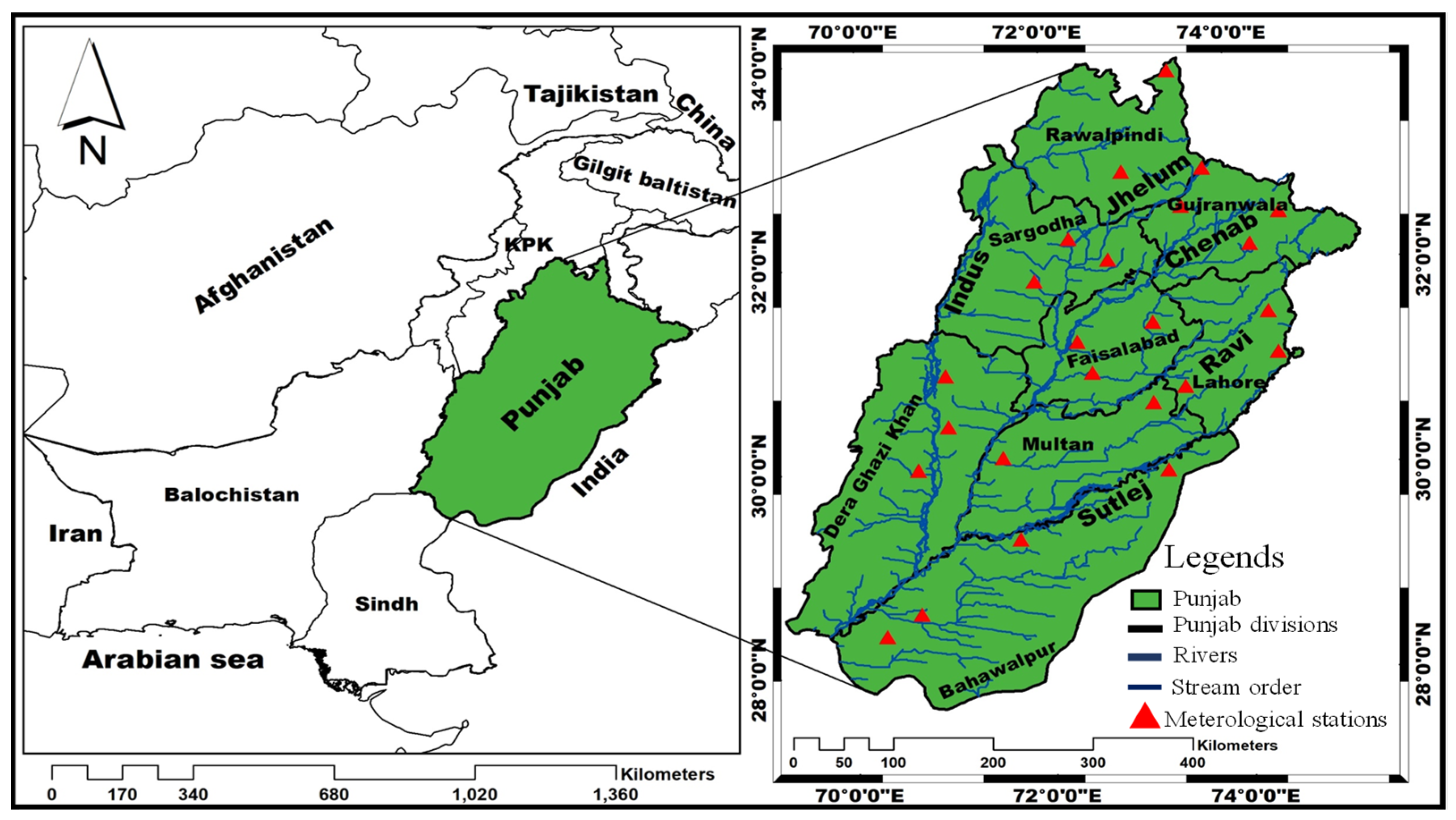
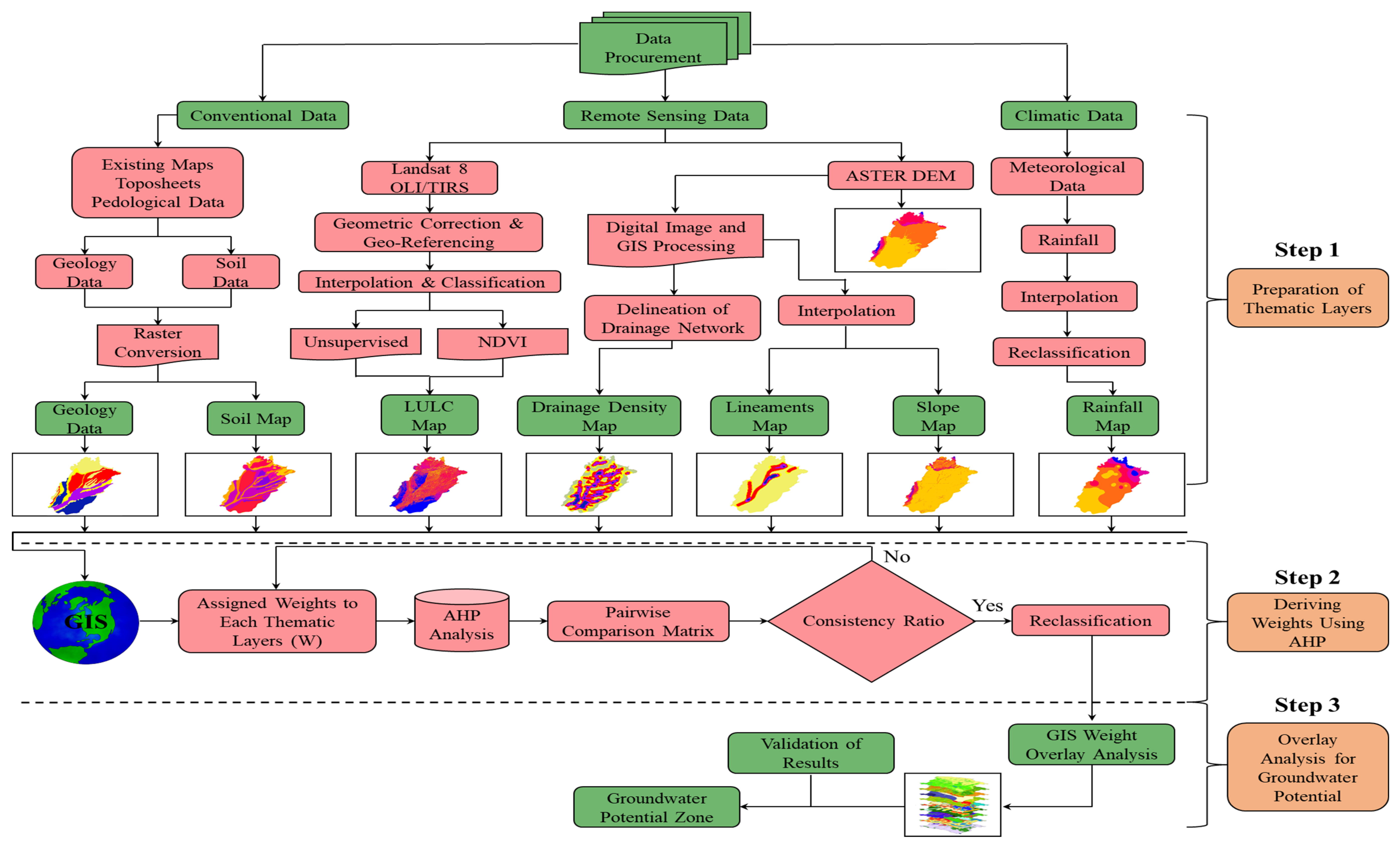

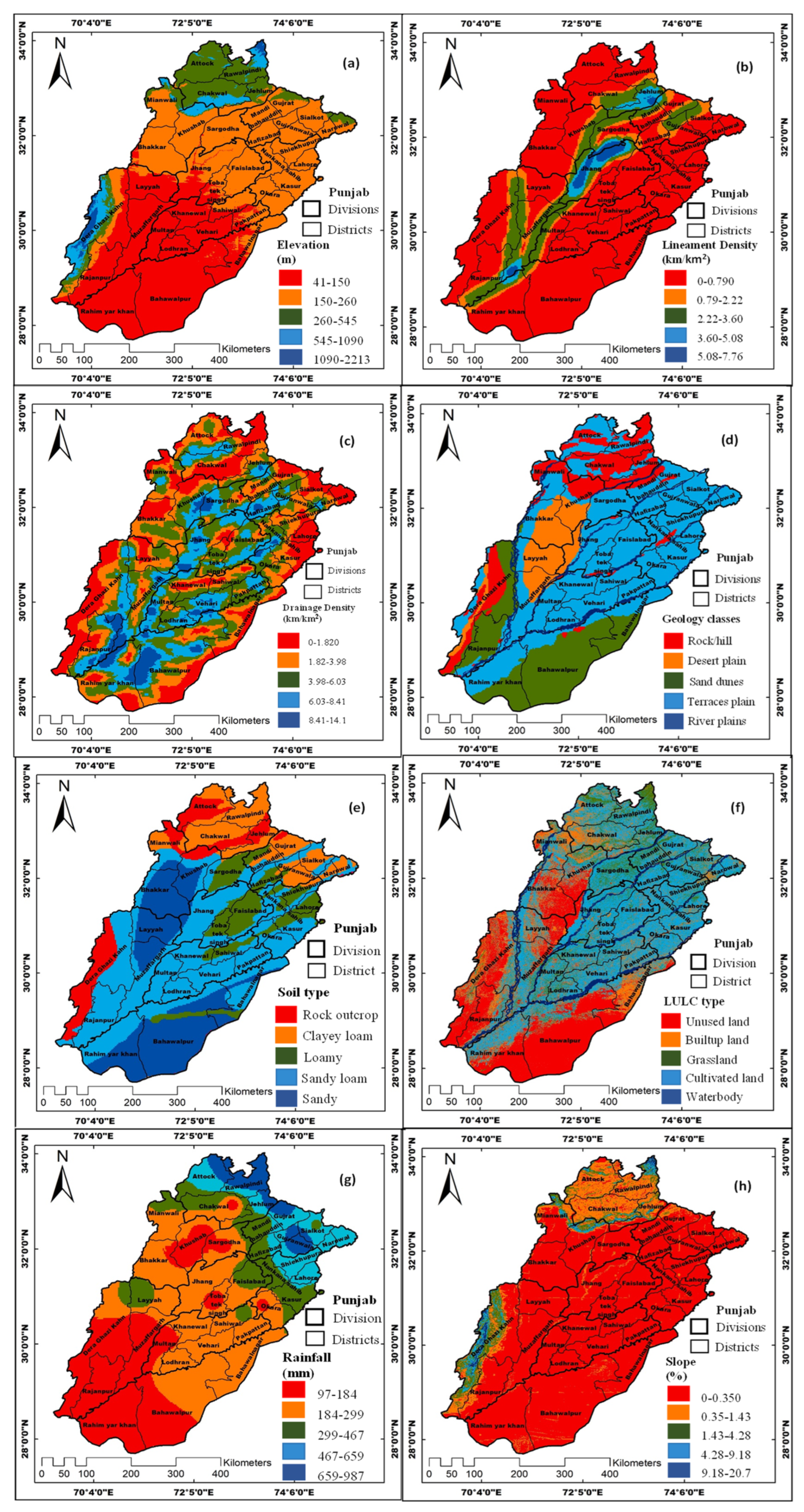

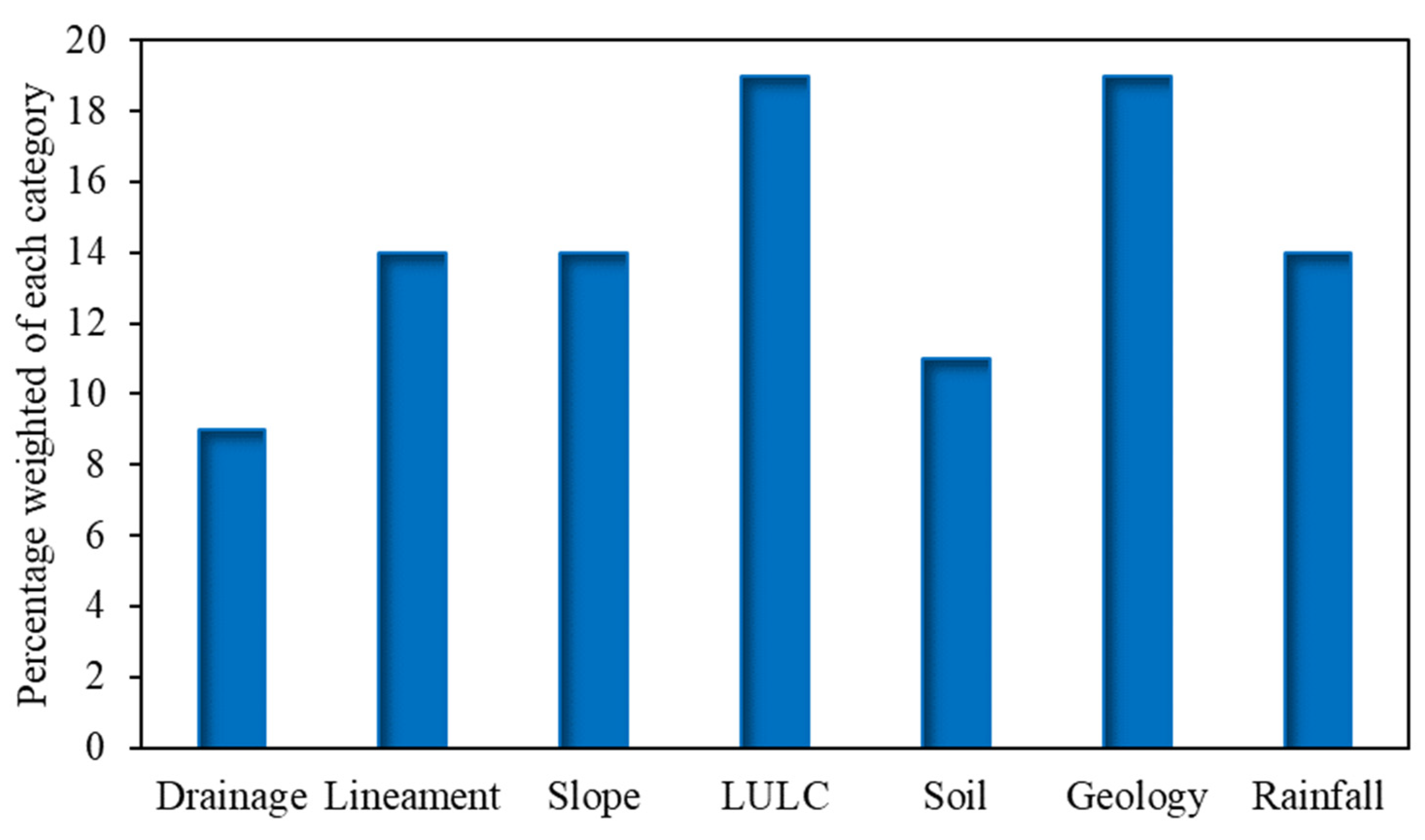

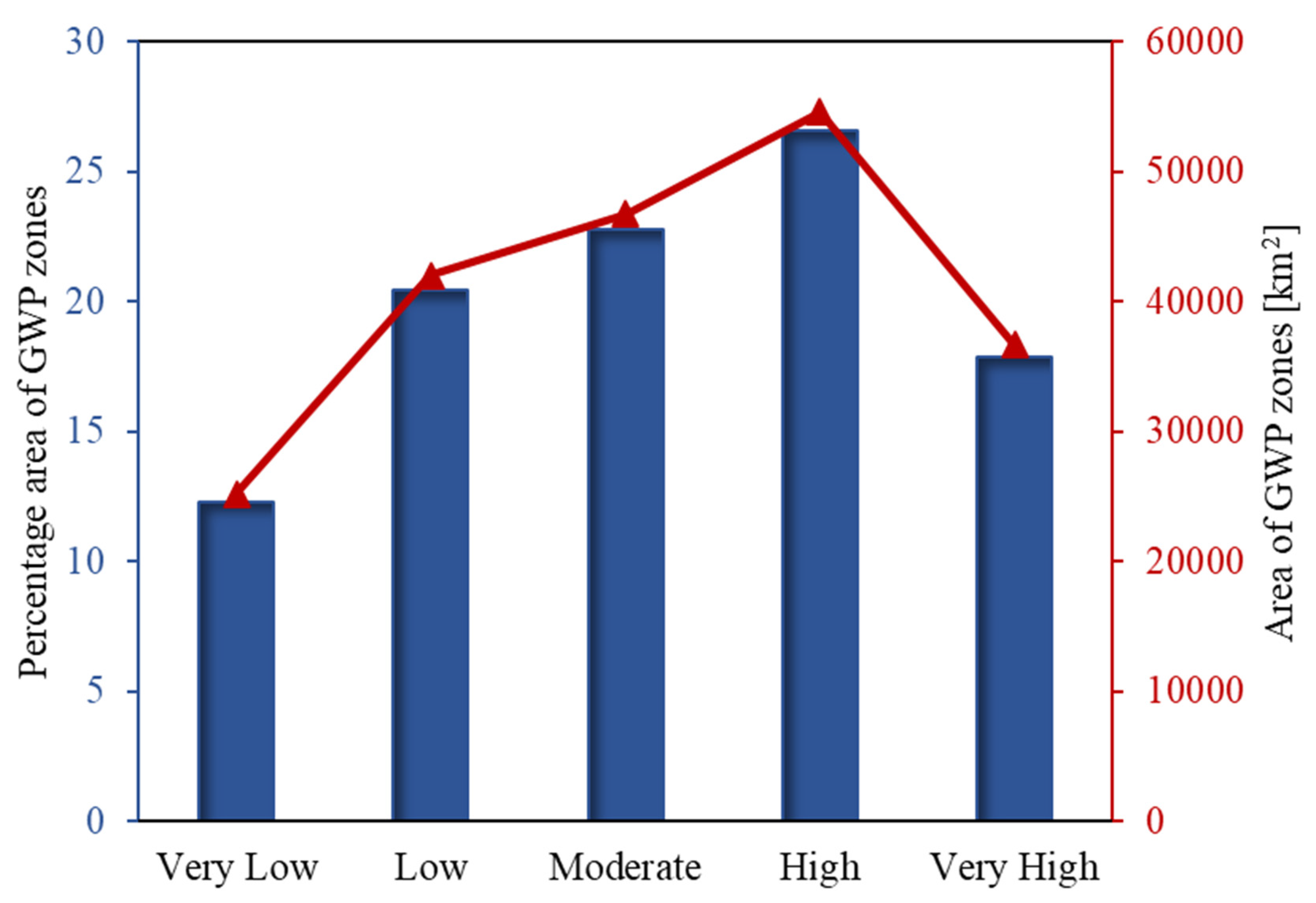
| Sr. No. | Acquisition Date | Row | Path | Cloud Cover | Sun Azimuth | Sun Elevation |
|---|---|---|---|---|---|---|
| 1 | 25 November 2021 | 148 | 38 | 0.5 | 158.93 | 34.57 |
| 2 | 16 November 2021 | 149 | 37 | 7.5 | 159.43 | 35.38 |
| 3 | 16 November 2021 | 149 | 38 | 0.01 | 158.74 | 36.63 |
| 4 | 16 November 2021 | 149 | 39 | 7 | 158.02 | 37.88 |
| 5 | 16 November 2021 | 149 | 40 | 8.23 | 157.27 | 39.11 |
| 6 | 23 November 2021 | 150 | 36 | 4.45 | 160.23 | 32.48 |
| 7 | 23 November 2021 | 150 | 37 | 0.94 | 159.59 | 33.74 |
| 8 | 23 November 2021 | 150 | 38 | 0.1 | 158.93 | 34.99 |
| 9 | 23 November 2021 | 150 | 39 | 0.03 | 158.25 | 36.24 |
| 10 | 23 November 2021 | 150 | 40 | 0.04 | 157.55 | 37.48 |
| 11 | 23 November 2021 | 150 | 41 | 0.1 | 156.81 | 38.72 |
| 12 | 30 November 2021 | 151 | 37 | 8.5 | 159.48 | 32.35 |
| 13 | 30 November 2021 | 151 | 38 | 0.08 | 158.84 | 33.60 |
| 14 | 30 November 2021 | 151 | 39 | 0 | 158.19 | 34.85 |
| 15 | 30 November 2021 | 151 | 40 | 2.6 | 157.51 | 36.09 |
| 16 | 30 November 2021 | 151 | 41 | 7.13 | 156.80 | 37.33 |
| Sr. No. | Thematic Layer | Data Source | Data Type | Processing |
|---|---|---|---|---|
| 1 | Base map | Survey of Pakistan | Polygon | Slope in percentage |
| 2 | Drainage | DEM (USGS Website) | Raster | Using spatial analyst tool |
| 3 | Lineament | DEM (USGS Website) | Raster | Using line density from spatial analyst tool |
| 4 | Slope | DEM (USGS Website) | Raster | Digital Elevation Model (DEM) |
| 5 | LULC | Landsat 8 OLI | Raster | Unsupervised classification |
| 6 | Soil | Soil Survey of Pakistan | Polygon | Geo-referenced and converted into raster data |
| 7 | Geology | Geological Survey of Pakistan | Polygon | Geo-referenced and converted into raster data |
| 8 | Rainfall | Pakistan Meteorological Department (PDM) | Number | Interpolation of rainfall data using IDW technique |
| Sr. No. | Parameter | Major Effect (A) | Minor Effect (B) | Proposed Relative Rates (A + B) | Proposed Weight of Each Influencing Parameter |
|---|---|---|---|---|---|
| 1 | Drainage | 1 | 0.5 | 1.5 | 8.3 |
| 2 | Lineament | 1 + 1 | 0.5 | 2.5 | 13.9 |
| 3 | Slope | 1 + 1 | 0.5 | 2.5 | 13.9 |
| 4 | LULC | 1 + 1 | 0.5 + 0.5 + 0.5 | 3.5 | 19.4 |
| 5 | Soil | 1 | 0.5 + 0.5 | 2 | 11.1 |
| 6 | Geology | 1 + 1 + 1 | 0.5 | 3.5 | 19.4 |
| 7 | Rainfall | 1 + 1 | 0.5 | 2.5 | 13.9 |
| Total | 13 | 5 | 18 | 100 |
| Intensity of Importance | Definitions |
|---|---|
| 1 | Equal importance |
| 2 | Equal to moderate importance |
| 3 | Moderate importance |
| 4 | Moderate to strong importance |
| 5 | Strong importance |
| 6 | Strong to very strong importance |
| 7 | Very strong importance |
| 8 | Very to extremely strong importance |
| 9 | Extreme importance |
| Scale | Degree of Preferences | Description |
|---|---|---|
| 1 | Equally important | The influence of two factors is equal to the objective |
| 3 | Slightly important | Judgment and experiences slightly favor a certain factor |
| 5 | Moderately important | Judgment and experiences moderately favor a certain factor |
| 7 | Strongly important | Judgment and experiences strongly favor a certain factor |
| 9 | Extremely important | Judgment and experiences extremely favor a certain factor with sufficient evidence |
| 2, 4, 6, 8 | Intermediate values | In between two adjacent judgments |
| Sr. No. | Parameter | Basis of Categorization |
|---|---|---|
| 1 | Drainage | Drainage density value |
| 2 | Lineament | Lineament density value |
| 3 | Slope | Percentage slope |
| 4 | LULC | Land cover status, areal extent, condition, associated vegetation |
| 5 | Soil | Texture, porosity, and permeability |
| 6 | Geology | Rock type, joints, fractures, weathering character |
| 7 | Rainfall | Average annual rainfall |
| LULC | Description |
|---|---|
| Waterbody | Area accumulates open water bodies, perennial canals rivers, and man-made structures including reservoirs and dams |
| Built-up land | Land categorized by different settlements including residential, commercial, industrial, and man-made infra-structures |
| Cultivated land | Land capable of plowing, sowing and growing crops |
| Grassland | A biome, a land where vegetation is dominated by grasses. |
| Unused land | A vacant area of land without vegetation, public utilities, buildings, etc. |
| Variable Layers | LULC | Geology | Lineament | Slope | Rainfall | Soil | Drainage | Normalized Weight |
|---|---|---|---|---|---|---|---|---|
| LULC | 1 | 1/7 | 1/5 | 1/2 | 1/3 | 1/4 | 1/9 | 0.194 |
| Geology | 7 | 1 | 3 | 6 | 5 | 1/3 | 2 | 0.194 |
| Lineament | 5 | 1/3 | 1 | 4 | 3 | 2 | 1/6 | 0.139 |
| Slope | 2 | 1/6 | 1/4 | 1 | 1/2 | 1/3 | 5 | 0.139 |
| Rainfall | 3 | 1/5 | 1/3 | 2 | 1 | 1/2 | 1/4 | 0.139 |
| Soil | 4 | 3 | 1/2 | 3 | 2 | 1 | 1/3 | 0.111 |
| Drainage | 9 | 1/2 | 6 | 1/5 | 4 | 3 | 1 | 0.084 |
| 31 | 5.34 | 11.28 | 16.7 | 15.83 | 7.42 | 8.861 |
| Thematic Map | Proposed Weight | Sub-Class Features | Classes Ranking | GW Prospect (Qualitative Rank) | GW Prospect (Quantitative Rank) |
|---|---|---|---|---|---|
| 0–1.82 | Very low value | Very good | 9 | ||
| 1.82–3.98 | Low value | Good | 7 | ||
| Drainage | 9 | 3.98–6.03 | Moderate value | Moderate | 5 |
| 6.03–8.41 | High value | Poor | 3 | ||
| 8.41–14.11 | Very high value | Very poor | 1 | ||
| 0–0.79 | Very low value | Very poor | 1 | ||
| 0.79–2.22 | Low value | Poor | 3 | ||
| Lineament | 14 | 2.22–3.60 | Moderate value | Moderate | 5 |
| 3.60–5.08 | High value | Good | 7 | ||
| 5.08–7.76 | Very high value | Very good | 9 | ||
| 0–0.35 | Nearly level | Very good | 9 | ||
| 0.35–1.43 | Very gently sloping | Good | 7 | ||
| Slope (%) | 14 | 1.43–4.28 | Gently sloping | Moderate | 5 |
| 4.28–9.18 | Moderately sloping | Poor | 3 | ||
| 9.18–20.72 | Strong sloping | Very poor | 1 | ||
| Unused land | Very low infiltration | Very poor | 1 | ||
| Built-up land | Low infiltration | Poor | 3 | ||
| LULC | 19 | Grassland | Moderate infiltration | Moderate | 5 |
| Cultivated land | High infiltration | Good | 7 | ||
| Waterbody | Very high infiltration | Very good | 9 | ||
| Rock outcrop | Very low infiltration | Very poor | 1 | ||
| Clayey loam | Low infiltration | Poor | 3 | ||
| Soil | 11 | Loamy | Moderate infiltration | Moderate | 5 |
| Sandy loam | High infiltration | Good | 7 | ||
| Sandy | Very high infiltration | Very good | 9 | ||
| Rock/hill predominant plain | Very low infiltration | Very poor | 1 | ||
| Desert plain | Low infiltration | Poor | 3 | ||
| Geology | 19 | Sand dunes | Moderate infiltration | Moderate | 5 |
| Terraces plain | High infiltration | Good | 7 | ||
| River plains | Very high infiltration | Very good | 9 | ||
| 97–184 | Very low | Very poor | 1 | ||
| 184–299 | Low | Poor | 3 | ||
| Rainfall | 14 | 299–467 | Moderate | Moderate | 5 |
| 467–659 | High | Good | 7 | ||
| 659–987 | Very high | Very good | 9 |
| Sr. No. | GWPI | GW Prospect | Area (km2) | Percentage Area (%) |
|---|---|---|---|---|
| 1 | 0.11–0.16 | Very Low | 25,203 | 12.27 |
| 2 | 0.16–0.19 | Low | 42,060 | 20.48 |
| 3 | 0.19–0.22 | Moderate | 46,751 | 22.77 |
| 4 | 0.22–0.25 | High | 54,610 | 26.59 |
| 5 | 0.25–0.31 | Very High | 36,720 | 17.88 |
Disclaimer/Publisher’s Note: The statements, opinions and data contained in all publications are solely those of the individual author(s) and contributor(s) and not of MDPI and/or the editor(s). MDPI and/or the editor(s) disclaim responsibility for any injury to people or property resulting from any ideas, methods, instructions or products referred to in the content. |
© 2024 by the authors. Published by MDPI on behalf of the International Society for Photogrammetry and Remote Sensing. Licensee MDPI, Basel, Switzerland. This article is an open access article distributed under the terms and conditions of the Creative Commons Attribution (CC BY) license (https://creativecommons.org/licenses/by/4.0/).
Share and Cite
Naeem, M.; Farid, H.U.; Madni, M.A.; Albano, R.; Inam, M.A.; Shoaib, M.; Shoaib, M.; Rashid, T.; Dilshad, A.; Ahmad, A. GIS-Based Analytical Hierarchy Process for Identifying Groundwater Potential Zones in Punjab, Pakistan. ISPRS Int. J. Geo-Inf. 2024, 13, 317. https://doi.org/10.3390/ijgi13090317
Naeem M, Farid HU, Madni MA, Albano R, Inam MA, Shoaib M, Shoaib M, Rashid T, Dilshad A, Ahmad A. GIS-Based Analytical Hierarchy Process for Identifying Groundwater Potential Zones in Punjab, Pakistan. ISPRS International Journal of Geo-Information. 2024; 13(9):317. https://doi.org/10.3390/ijgi13090317
Chicago/Turabian StyleNaeem, Maira, Hafiz Umar Farid, Muhammad Arbaz Madni, Raffaele Albano, Muhammad Azhar Inam, Muhammad Shoaib, Muhammad Shoaib, Tehmena Rashid, Aqsa Dilshad, and Akhlaq Ahmad. 2024. "GIS-Based Analytical Hierarchy Process for Identifying Groundwater Potential Zones in Punjab, Pakistan" ISPRS International Journal of Geo-Information 13, no. 9: 317. https://doi.org/10.3390/ijgi13090317
APA StyleNaeem, M., Farid, H. U., Madni, M. A., Albano, R., Inam, M. A., Shoaib, M., Shoaib, M., Rashid, T., Dilshad, A., & Ahmad, A. (2024). GIS-Based Analytical Hierarchy Process for Identifying Groundwater Potential Zones in Punjab, Pakistan. ISPRS International Journal of Geo-Information, 13(9), 317. https://doi.org/10.3390/ijgi13090317







